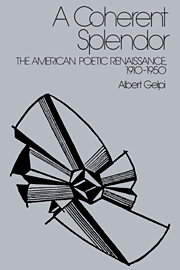Book contents
- Frontmatter
- Contents
- Acknowledgments
- Dedication
- Introduction. The Janus-Face of Romanticism and Modernism
- 1 Robert Frost and John Crowe Ransom: Diptych of Ironists, the Woodsman and the Chevalier
- 2 Wallace Stevens: World as Mundo, Mundo as World
- 3 T. S. Eliot: The Lady Between the Yew Trees
- 4 Ezra Pound: Between Kung and Elcusis
- 5 H. D.: Helen in Bethlehem, Hilda in Egypt
- 6 William Carlos Williams: Mother-Son and Paterson
- 7 Allen Tate and Hart Crane: Diptych with Angels and Demons
- Coda. Yvor Winters and Robinson Jeffers: The Janus-Face of Anti-Modernism
- Notes
- Index
5 - H. D.: Helen in Bethlehem, Hilda in Egypt
Published online by Cambridge University Press: 22 January 2010
- Frontmatter
- Contents
- Acknowledgments
- Dedication
- Introduction. The Janus-Face of Romanticism and Modernism
- 1 Robert Frost and John Crowe Ransom: Diptych of Ironists, the Woodsman and the Chevalier
- 2 Wallace Stevens: World as Mundo, Mundo as World
- 3 T. S. Eliot: The Lady Between the Yew Trees
- 4 Ezra Pound: Between Kung and Elcusis
- 5 H. D.: Helen in Bethlehem, Hilda in Egypt
- 6 William Carlos Williams: Mother-Son and Paterson
- 7 Allen Tate and Hart Crane: Diptych with Angels and Demons
- Coda. Yvor Winters and Robinson Jeffers: The Janus-Face of Anti-Modernism
- Notes
- Index
Summary
For women like Hilda Doolittle, Marianne Moore, and Amy Lowell, trying to define themselves as poets between 1910 and 1920, there seemed no available female predecessors – only their struggling selves. Even Emily Dickinson was not available; the posthumous interest Dickinson received in the 1890s had passed, and it was not until the 1920s that rediscovery would bring out new poems and renewed attention. Even then, when she was taken up as a proto-Modernist in technique, her sensibility seemed too cloistered and renunciatory for the liberated 1920s, too bourgeois and self-involved for the Marxist 1930s.
Amy Lowell, shortly before her death in 1925, began “The Sisters,” a monologue about the melancholy and loneliness of female poets, with these lines:
Taking us by and large, we're a queer lot
We women who write poetry. And when you think
How few of us there've been, it's queerer still.
I wonder what it is that makes us do it,
Singles us out to scribble down, man-wise,
The fragments of ourselves. Why are we
Already mother-creatures, double bearing,
With matrices in body and in brain?
Although the question is left hanging in the air, the suggestion is that the woman poet ought ideally to be a double mother “with matrices in body and in brain.” But if the challenge or the circumstances of patriarchy proved too daunting, can she still be mother in brain, if not in body? Can her poems become the parthenogenetic offspring of her “man-wise” powers, which proclaim her at once mother and daughter and virgin?
These remained rueful questions for Amy Lowell. She had not herself been “double bearing”; like Dickinson and Moore, she died childless and unmarried.
- Type
- Chapter
- Information
- A Coherent SplendorThe American Poetic Renaissance, 1910–1950, pp. 253 - 320Publisher: Cambridge University PressPrint publication year: 1988



